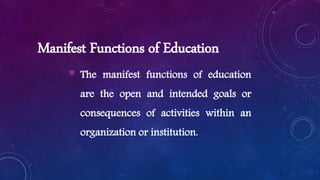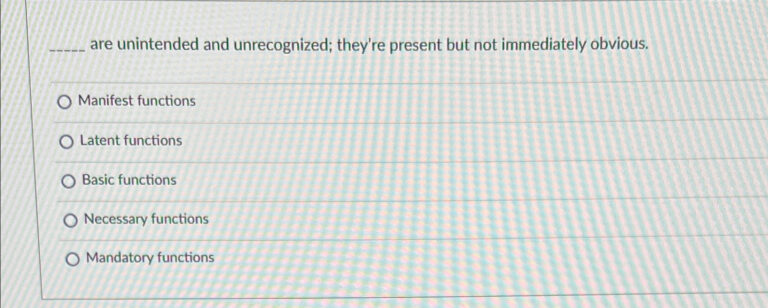Manifest And Latent Functions of Education!
Manifest functions of education are the intended and recognized outcomes, such as knowledge acquisition and socialization. Latent functions include unintended consequences, like social networks and cultural transmission.
Education plays a vital role in shaping individuals and society. It provides essential knowledge and skills that empower students for future opportunities. Beyond academics, education fosters social cohesion and cultural values. Schools serve as a microcosm of society, where students learn to collaborate, compete, and communicate.
The dynamics of classroom interactions also help build lasting relationships. Understanding both manifest and latent functions reveals the complex nature of education. This dual perspective enhances our appreciation of its broader impact on personal development and societal growth. Exploring these functions deepens our insight into the educational landscape.

Introduction To Manifest And Latent Functions
Education plays a vital role in society. It has both clear and hidden purposes. Understanding these functions helps us grasp its impact. Let’s explore the concepts of manifest and latent functions in education.
Briefing The Dual Role Of Education
Education serves two main roles:
- Manifest Functions
- Latent Functions
Manifest functions are the obvious outcomes of education. These include:
- Knowledge acquisition
- Skill development
- Socialization
- Preparation for employment
Latent functions are the hidden outcomes. These may not be immediately visible. They include:
- Social networks creation
- Cultural transmission
- Reinforcement of social norms
- Class stratification
The Sociological Lens
Using a sociological lens helps analyze education’s role. This perspective reveals how education affects society. It shows how education influences:
| Aspect | Manifest Functions | Latent Functions |
|---|---|---|
| Knowledge | Learning facts and concepts | Developing critical thinking |
| Skills | Vocational training | Building teamwork abilities |
| Socialization | Meeting diverse people | Understanding social hierarchy |
Education not only teaches facts. It shapes values and behaviors. Understanding these functions leads to better educational policies. It also helps improve student experiences.

Breaking Down Manifest Functions
The manifest functions of education serve clear and visible purposes. These functions directly impact individuals and society. Understanding these can help us appreciate the value of education.
Knowledge Acquisition
Education primarily focuses on knowledge acquisition. Students learn various subjects, such as:
- Mathematics
- Science
- Literature
- History
This knowledge helps students understand the world. It also prepares them for informed citizenship.
Skill Development
Another key function is skill development. Schools teach essential skills like:
- Critical thinking
- Problem-solving
- Teamwork
- Communication
These skills are vital in daily life. They help students succeed in future jobs.
Career Preparation
Education aims for career preparation. It equips students for the workforce. Through various programs, students learn:
| Program Type | Skills Taught |
|---|---|
| Vocational Training | Technical skills for trades |
| College Education | Specialized knowledge for professions |
| Internships | Real-world experience |
Career preparation ensures that students are ready for jobs. It also supports economic growth.
Exploring Latent Functions
The latent functions of education go beyond academics. They shape behavior and social skills. Understanding these functions helps us grasp education’s broader impact.
Socialization And Norms
Education plays a key role in socialization. It teaches students how to interact with others. Schools are places where children learn social norms. They understand what is acceptable and what is not.
- Group activities promote teamwork.
- Classroom rules establish boundaries.
- Peer interactions develop communication skills.
Through these experiences, students learn to respect differences. This knowledge helps them navigate the world outside school.
Hidden Curriculum
The hidden curriculum refers to lessons that are not officially taught. These lessons shape values and attitudes. They include:
- Discipline: Students learn the importance of following rules.
- Work Ethic: Completing assignments teaches responsibility.
- Critical Thinking: Discussions encourage independent thought.
These elements influence personal growth. They prepare students for challenges in life.
Network Building
Education fosters network building among peers. Students form relationships that last a lifetime. These connections can be beneficial in various ways:
| Type of Network | Benefits |
|---|---|
| Friendships | Emotional support and companionship |
| Professional Connections | Job opportunities and mentorship |
| Collaborative Projects | Teamwork and shared goals |
These networks contribute to personal and professional success. They open doors for future opportunities.
Historical Perspectives On Educational Functions
The history of education reveals its complex roles in society. Education serves not only to impart knowledge but also to shape values and norms. Understanding its manifest and latent functions helps us grasp its impact over time.
Influential Sociological Theories
Several sociological theories have shaped our understanding of education. Here are some key ideas:
- Functionalism: Education maintains social stability. It prepares individuals for their roles in society.
- Conflict Theory: Education reflects social inequalities. It can perpetuate class differences.
- Symbolic Interactionism: Education focuses on individual experiences. It emphasizes interactions between students and teachers.
Each theory offers a unique lens. They help identify how education functions manifest in society.
Evolution Of Educational Goals
Over the years, educational goals have evolved. Here’s a brief timeline:
| Era | Goals of Education |
|---|---|
| Ancient Times | Focus on moral and physical training. |
| Middle Ages | Emphasis on religious teachings. |
| Industrial Revolution | Preparation for the workforce. |
| 21st Century | Critical thinking and global citizenship. |
These changes highlight how education adapts to societal needs. The shift from traditional to modern goals shows a broader perspective on learning.
- Education now promotes creativity.
- It encourages collaboration among students.
- Technology integration is key in today’s classrooms.
Understanding these historical perspectives enriches our view of education today. It also points to potential future trends.
Case Studies
Case studies reveal the manifest and latent functions of education. They show how different systems operate. These insights help us understand the broader impacts of education.
Comparative Educational Systems
Different countries have unique educational systems. Here are two examples:
| Country | Manifest Functions | Latent Functions |
|---|---|---|
| Finland |
|
|
| United States |
|
|
Impact Assessments
Impact assessments measure educational outcomes. They help us understand both manifest and latent functions.
Key areas of focus include:
- Academic Performance: Test scores reflect knowledge gained.
- Social Skills: Group projects build teamwork abilities.
- Long-term Success: Education affects career choices and income.
Data from assessments can guide improvements. Schools can adapt curricula based on findings. This enhances both manifest and latent functions.
Critiques And Debates
The discussion around the manifest and latent functions of education is lively. Scholars and educators often debate its role in society. Critics highlight various aspects, questioning the traditional views. Different theories provide contrasting perspectives on education’s purpose. Understanding these critiques helps clarify education’s impact.
Functionalist Vs Conflict Theories
Functionalist theory views education as a tool for social stability. It focuses on how education meets societal needs. Key functions include:
- Socialization: Teaching cultural norms and values.
- Integration: Uniting diverse groups within society.
- Skill Development: Preparing individuals for the workforce.
On the other hand, conflict theory critiques this view. It argues education reinforces social inequalities. Key points include:
- Access Disparities: Not everyone has equal educational opportunities.
- Cultural Bias: Curriculum reflects dominant culture, neglecting others.
- Economic Advantage: Wealthier families often secure better education.
| Aspect | Functionalist View | Conflict View |
|---|---|---|
| Purpose | Social Stability | Social Inequality |
| Key Focus | Integration | Access Disparities |
| Outcome | Preparation for Society | Reinforcement of Class Structures |
Modern Educational Challenges
Today’s education faces numerous challenges. These issues spark ongoing debates among educators and theorists. Key challenges include:
- Equity in Education: Ensuring all students receive equal resources.
- Standardized Testing: Questioning its effectiveness in measuring knowledge.
- Technological Advancements: Adapting to new learning tools and methods.
- Globalization: Addressing diverse cultural needs in education.
Each challenge highlights important discussions. Stakeholders must consider the implications for future generations. This ongoing dialogue shapes how education evolves.
Implications For Policy And Reform
Understanding the manifest and latent functions of education shapes effective policy. Manifest functions are clear and intended goals of education. These include knowledge acquisition and skill development. Latent functions are hidden and often unintended outcomes. These may include social networking and cultural integration.
Policymakers must recognize both functions. This understanding leads to better education reforms. It also helps in addressing broader social issues.
Reforming Manifest Functions
To reform manifest functions, focus on the following areas:
- Curriculum Development: Ensure it meets current job market needs.
- Teacher Training: Equip educators with modern teaching techniques.
- Assessment Methods: Move beyond standardized tests to evaluate students’ diverse skills.
These reforms enhance the primary educational goals. They ensure students gain relevant knowledge and skills.
Addressing Latent Functions
Latent functions also require attention. Consider these strategies:
- Foster Inclusivity: Create programs that promote diversity and acceptance.
- Encourage Extracurricular Activities: Support clubs and sports to build social skills.
- Community Engagement: Involve families and local organizations in school events.
Addressing latent functions enhances the social fabric of communities. Schools become places for positive social interactions.
| Function Type | Examples | Policy Implications |
|---|---|---|
| Manifest | Knowledge, Skills | Focus on relevant curriculum and effective teaching. |
| Latent | Social Skills, Networking | Encourage community involvement and inclusivity. |

Frequently Asked Questions
What Are The Latent Functions Of The Education System?
Latent functions of the education system include social integration, cultural transmission, and the development of social networks. It fosters critical thinking and prepares individuals for future roles. Education also promotes social norms and values, contributing to social stability and cohesion within communities.
What Is A Manifest Function Of Education?
A manifest function of education is to transmit knowledge and skills. It prepares individuals for the workforce and promotes socialization. Education fosters critical thinking and helps develop informed citizens. These functions contribute to personal growth and societal progress.
What Is An Example Of A Manifest And Latent Function?
A manifest function is the intended outcome of education, such as acquiring knowledge. A latent function might be forming social networks and friendships that occur alongside learning, but are not the primary goal. Both functions illustrate the complex roles of education in society.
Which Of The Following Is An Example Of Manifest Function Of Education?
An example of a manifest function of education is the transmission of knowledge and skills. Education prepares students for future careers and societal roles. It promotes social integration and helps develop critical thinking abilities essential for informed citizenship.
Conclusion
Education serves multiple purposes beyond just academics. Its manifest functions include knowledge acquisition and skill development. Meanwhile, latent functions encompass social integration and cultural transmission. Understanding both aspects enriches our perspective on education’s role in society. Embracing these functions can lead to a more informed and engaged citizenry.





